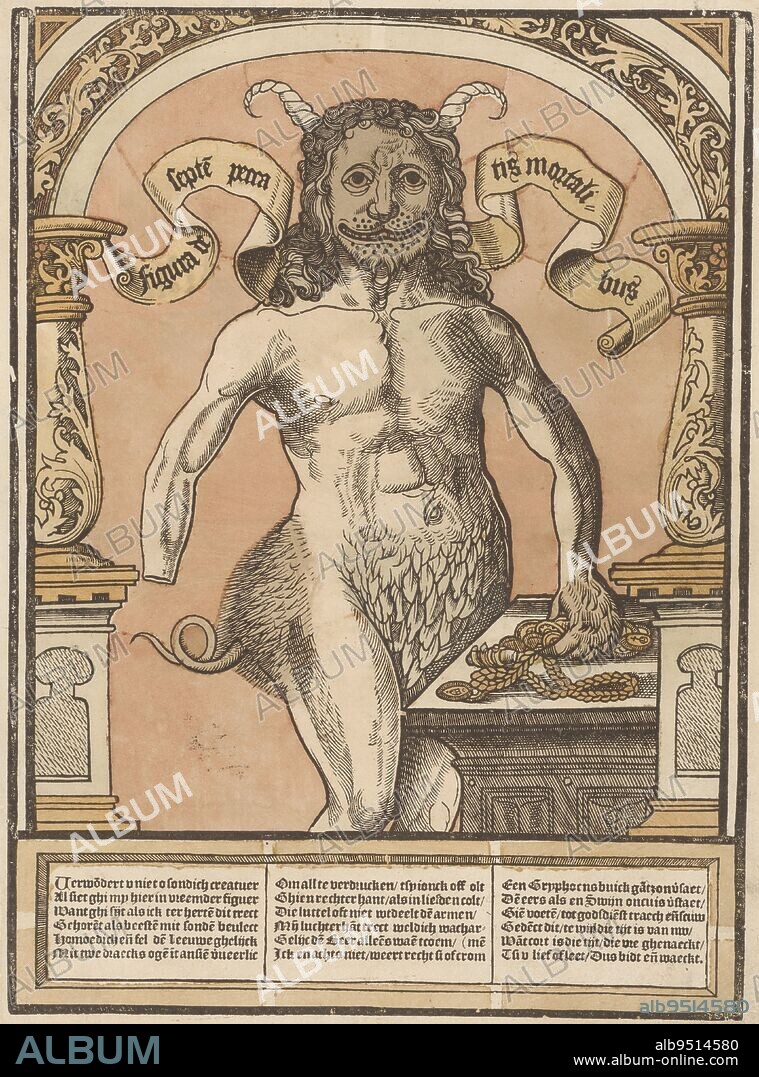alb9514580
The Seven Deadly Sins, anonymous, 1540 - 1567, Devil figure composed of body parts of various animals, personifying the seven deadly sins. Standing in a niche. The lion's head symbolizes Pride, the dragon's eyes represent Wrath, the absence of the right hand represents Avarice, and the hindquarters of a boar represent Unchastfulness. On either side of the head the text: Figura de septe peccatis mortalibus. The way the monster is represented goes back in part to a poem by Hans Sachs: 'Der Eygennutz, das Grewlich Thier', 1535. Below text in Dutch in three columns., print maker: anonymous, publisher: Peter Warnerssen, (mentioned on object), print maker: Low Countries, publisher: Kampen, 1540 - 1567, paper, h 395 mm × w 278 mm.

|
Ajouter à une autre Lightbox |
|
Ajouter à une autre Lightbox |



Avez-vous déjà un compte? S'identifier
Vous n'avez pas de compte ? S'inscrire
Acheter cette image.
Sélectionnez l'usage:

Légende:
Voir la traduction automatique
The Seven Deadly Sins, anonymous, 1540 - 1567, Devil figure composed of body parts of various animals, personifying the seven deadly sins. Standing in a niche. The lion's head symbolizes Pride, the dragon's eyes represent Wrath, the absence of the right hand represents Avarice, and the hindquarters of a boar represent Unchastfulness. On either side of the head the text: Figura de septe peccatis mortalibus. The way the monster is represented goes back in part to a poem by Hans Sachs: 'Der Eygennutz, das Grewlich Thier', 1535. Below text in Dutch in three columns., print maker: anonymous, publisher: Peter Warnerssen, (mentioned on object), print maker: Low Countries, publisher: Kampen, 1540 - 1567, paper, h 395 mm × w 278 mm
Crédit:
Album / quintlox
Autorisations:
Modèle: Non - Propriété: Non
Questions sur les droits?
Questions sur les droits?
Taille de l'image:
4154 x 5605 px | 66.6 MB
Taille d'impression:
35.2 x 47.5 cm | 13.8 x 18.7 in (300 dpi)
Mots clés:
ABSENCE • DEBOUT • HOLLANDAIS • HOLLANDAISE • MONSTRE • OBJET • PAPIER • PECHE MORTEL • PORTE DISPARU • SEPT PECHES CAPITAUX • TETE (ANATOMIE) • TETE • TEXTE • VETEMENT: HOLLANDAIS
 Pinterest
Pinterest Twitter
Twitter Facebook
Facebook Copier le lien
Copier le lien Email
Email
